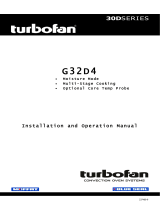
Part # 1936601 Rev. 6 (01/08) Page 19
Note: When the door is opened for loading, the internal
temperature is likely to drop below the ready range. This is
expected. The control allows 3 minutes for a user to load the
product, close the door and press the Start/Cancel key to
engage the timer. During this time, the control will ignore
the drop in temperature. If the door is left open longer than 3
minutes, the cook cycle and timer countdown will not begin
until the oven returns to the set temperature ready range and
the display again indicates READY. If this happens, unload
the oven, close the door, wait for the oven to return to READY,
then repeat steps 7 and 8.
9. When time has expired the display will indicate DONE and
an audible alarm will sound continuously for 3 seconds.
The fan will engage at low speed and the timer display will
begin counting up from 00:00:00, indicating the amount
of time the product has been held. The Cook/Hold key LED
will ash.
The oven will continue to idle at the programmed HOLD
temperature until the function is canceled. If there was a
moisture setting active during the Cook cycle, moisture
will remain active during the Hold cycle. Press the Start/
Cancel key once to cancel the Hold and clear the timer.
Unload the nished-then-held product from the oven
immediately. The fan and heat will continue in Idle Mode,
(at the programmed COOK temperature).
Cooking With a Core Probe
1. Press the Cook/Hold key once to activate the cook & hold
function. The Cook/Hold key LED will light.
2. Press the Program key once. The display will indicate
PROGRAM COOK TEMP. Use the numeric keys to enter the
desired cook temperature.
Enter a number between 150 and 500, (factory default is
300). If a number outside this range is entered, the control
will sound an error tone and reset to the closest allowable
number within the range.
3. Press the Program key a second time. This stores and
implements the temperature setting. The display will
indicate PROGRAM COOK TIME. When cooking with a core
probe, the COOK TIME setting is ignored. The controller
will override the time setting and monitor the probe
temperature.
4. Press the Program key a third time. The display will
indicate PROGRAM MOISTURE.
Press the N/Scroll key repeatedly to step through the
available moisture setting choices until the desired setting
is displayed. Moisture setting presets for Meat, Bread,
Poultry, Fish and None are included, along with a User
setting to allow for custom settings.
5. Press the Program key a fourth time. This stores and
implements the moisture setting. The display will indicate
PROGRAM HOLD TEMP. Use the numeric keys to enter the
desired Hold temperature.
Enter a number between 140 and 300, (factory default is
160). If a number outside this range is entered, the control
will sound an error tone and reset to the closest allowable
number within the range. If a new Hold temperature
is not entered, the control will use the most recently
programmed Hold temperature.
6. Press the Program key a fth time. This stores and
implements the Hold temperature. This also exits
programming mode.
7. Allow the oven to heat to the set temperature. When the
programmed temperature has been reached, the display
will indicate READY.
8. Insert the core probe into the food product to be
monitored. Load the oven, close the door, keeping the
plug-end of the probe cable outside the oven.
Note: When the door is opened for loading, the internal
temperature is likely to drop below the ready range. This is
expected. The control allows 3 minutes for a user to load the
product, close the door and press the Start/Cancel key to
engage the timer. During this time, the control will ignore
the drop in temperature. If the door is left open longer than 3
minutes, the cook cycle and timer countdown will not begin
until the oven returns to the set temperature ready range and
the display again indicates READY. If this happens, unload
the oven, close the door, wait for the oven to return to READY,
then repeat steps 7 and 8.
9. Plug the probe cable into the connector on the underside
of the top cover above the control panel. The display will
indicate PROGRAM PROB TEMP. Use the numeric keys to
enter the desired internal product temperature at which
the probe will signal that the product is done.
Enter a number between 120 and 300, (factory default is
150). If a number outside this range is entered, the control
will sound an error tone and reset to the closest allowable
number within the range.
10. Press the Program key. This stores and implements the
probe temperature setting. This also exits programming
mode and begins the cooking cycle. During the cooking
cycle, the display will ash at two second intervals,
alternately showing the programmed cook temperature
and the programmed probe temperature.
11. When the probe senses that the programmed internal
product temperature has been reached, the display
will indicate DONE and an audible alarm will sound
continuously for 3 seconds.
The fan will engage at low speed and the timer display will
begin counting up from 00:00:00, indicating the amount
of time the product has been held. The Cook/Hold key LED
will ash.
The oven will continue to idle at the programmed HOLD
temperature until the function is canceled. Press the Start/
Cancel key once to cancel the Hold and clear the timer.
Unload the nished-then-held product from the oven
immediately. The fan and heat will continue in Idle Mode,
(at the programmed COOK temperature).























